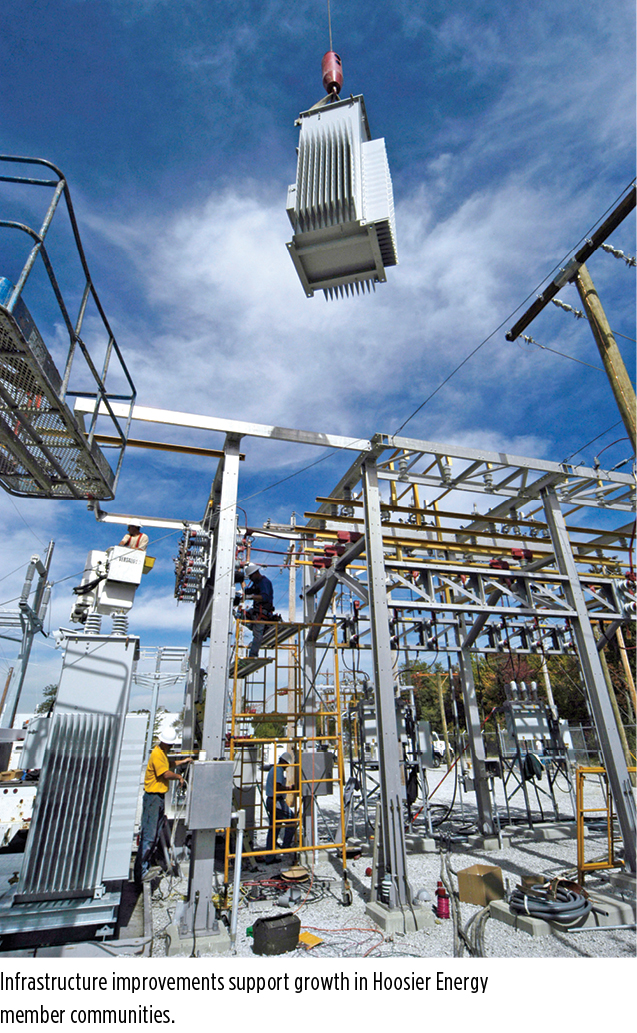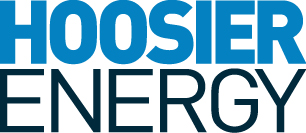Surrounded by rapid change and the risks that come with it, and looking toward the future with a diverse energy mix, Hoosier is balancing reliability and affordability with sustainability, seeking the most responsible energy transition across its 1,730-mile transmission network.
Hoosier is helping its communities and its 18 member cooperatives look forward too. Look no further than Liberty, Indiana, just northwest of Cincinnati. That’s where Whitewater Valley REMC in June broke ground for a new headquarters and operations center.
It’s the sixth move in the history of the cooperative. Talk about change. But through the cooperation that is their namesake, cooperatives speak from the same resilient playbook.
“All these moves have been the result of the changing needs of our member base and the physical needs of the rural electric cooperative business itself,” Whitewater Valley REMC President and CEO Mary Jo Thomas said in a news release. “What’s not changing is our commitment to our members and the communities we serve.”
The same could be said of the unchanging commitment of the Hoosier Energy economic development team, dedicated to strengthening the communities it serves by supporting existing business retention and expansion and new business development. But the vision goes beyond that, bringing statewide leadership, vision, action, experience and innovation to Hoosier’s markets and partners.
Working in partnership with their 18 member systems, the Hoosier Energy team helped cultivate around 1,200 new jobs at employers in Hoosier Energy territory who invested close to $1 billion in facility projects in 2022. “We were able to leverage existing programs and incentives such as an economic development rider and market-based rate along with green energy offerings such as renewable energy credits to win competitive deals,” Hoosier Energy Economic Development Manager Harold Gutzwiller said in Site Selection’s annual utility survey.
Those deals included a $445 million, 70-job processing plant expansion by St. Louis-based grain and soybean manufacturer Bunge in Morristown and a $300-million-plus, 550-job investment by Nhanced in a semiconductor packaging facility that will serve as the anchor tenant at WestGate One, the 10-acre microelectronics campus located at WestGate@Crane Technology Park in Odon, southwest of Bloomington.
The park is located next door to Naval Surface Warfare Center, Crane Division, the shore command of the U.S. Navy that is one of Indiana’s largest high-tech employers with over 3,800 employees, 2,500 of whom are scientists, engineers and technicians.
 Preparation and Vision
Preparation and Vision
Even as those big projects move forward, the Hoosier Energy team and its member systems advance in the background to prepare for the next project … and the one after that. Among future-focused projects is working with battery developer Delorean Power to secure a second U.S. Department of Energy grant for utility-scale, long-duration storage.
The team also continues to focus on site identification and development, supporting state and local economic development partners and enhancing its toolbox of programs and incentives.
The innovative new Cooperative Power Management Program (CPMP), for example, compensates industrial and large commercial member-consumers for electric load flexibility.
“Designed as a fair, viable and value-driven program to address emergency and economic events, the CPMP provides market capacity value to participants by incorporating load curtailment and access to Distributed Energy Resource (DER) opportunities,” Gutzwiller explains.
Meanwhile, Hoosier Energy’s member-served site and building inventory continues to expand.
“In collaboration with the Indiana Economic Development Corporation and local economic developers, we have expanded our site identification and development program by identifying large tracts of land with nearby amenities to meet the increasing demands of companies in emerging technologies such as semiconductors, clean tech and cloud computing,” Gutzwiller says, noting the vetting of the sites by a third-party engineering firm.
Not least among its initiatives is Hoosier Energy’s incorporation of an environmental, social and governance (ESG) framework into all operations and business strategy elements. Hoosier is one of the first electric cooperatives in the nation to do so. Why? It’s a familiar refrain: The ESG framework was developed in response to stakeholder and member consumer needs.
““We are creating flexibility for our members” says Gutzwiller, “by expanding the benefits of a cleaner electric grid with a more intentional focus on innovative and efficient energy solutions.”
After all, in the cooperative model, businesses aren’t just customers. They’re also member-owners.
“We are committed to establishing long-term relationships, not short-term transactions,” Gutzwiller said. “Our team is knowledgeable of local employers, available sites and buildings as well as hyperlocal data not available through most data subscription software and services. Our team’s knowledge and 70+ years of experience, combined with the ability to leverage the speed and flexibility offered by the cooperative model, results in a custom approach tailored to a business’s needs.”
His words echo those of Hoosier Energy President and CEO Donna Walker at the cooperative’s annual meeting in April: “How do we successfully plan for the future in the midst of extraordinary change and uncertainty?” she asked the audience. “We start by focusing on and understanding what’s most important to member systems and member-consumers at the end of the line.”
This Investment Profile was produced under the auspices of Hoosier Energy, a generation and transmission cooperative with headquartered in Bloomington, Indiana, that provides electric power and services to 18 member distribution cooperatives in central and southern Indiana and southeastern Illinois who serve more than 760,000 consumers. For more information, visit hoosierenergy.com.


